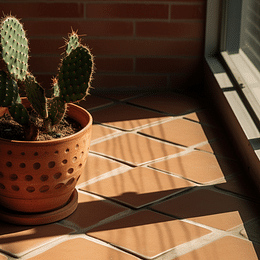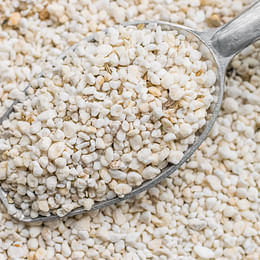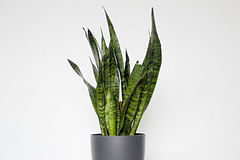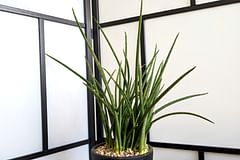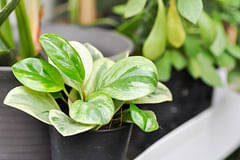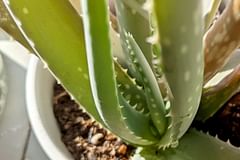How to care for a Sedum morganianum
If you like succulents and you also like bigger plants that grow vines, the Sedum morganianum is a fantastic plant for you! This succulent is very easy to take care of, like most other succulents. In this plant care guide, we're going to explore how to take care of your Sedum!
Last updated on:

Key learnings from this plant care guide
- The Sedum morganianum is an easy-to-care-for succulent that thrives with minimal attention and is perfect for succulent enthusiasts and those who love vines.
- Proper watering is essential for the health of your Sedum morganianum, allowing the plant to dry out between waterings and adjusting watering frequency based on sunlight exposure.
- Finding the right balance of sunlight exposure is key, as the Sedum morganianum can tolerate both bright and low-light conditions, but growth rate may vary.
- Creating a well-draining soil mixture and repotting when necessary will help your Sedum morganianum thrive, avoiding issues like root rot and compacted soil.
If you like succulents and you also like bigger plants that grow vines, the Sedum morganianum is a fantastic plant for you! This succulent is very easy to take care of, like most other succulents.
In this plant care guide, we're going to explore how to take care of your Sedum Morganianum. Whether you have a Burro's tail (Burrito) or a Donkey Tail, you can use this plant care guide to take care of your Sedum. These two different types of Sedum Morganianum are identical when taking care of them, they just look slightly different.
These are the topics we're going to look at in this plant care guide:
Let's discover how we can take care of your beautiful Sedum Morganianum and help it thrive in your house! If you've taken care of other succulents before, taking care of a Sedum Morganianum won't be much different than what you're used to. The Sedum Morganianum is a big plant, but it's still a succulent.
Watering your Sedum morganianum
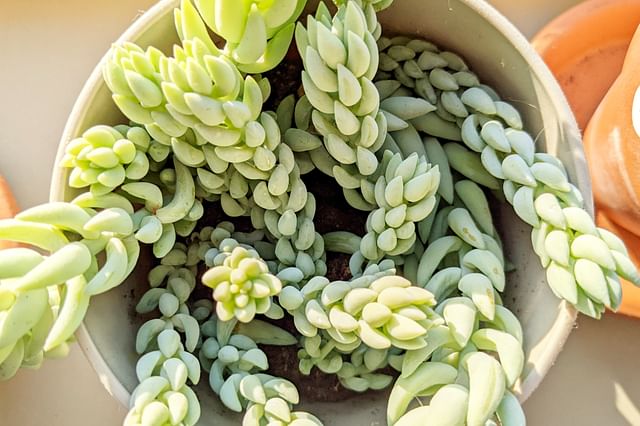
If you've taken care of succulents before, you'll know they thrive when they're dry for weeks at a time. Your Sedum is no different and loves to dry out for weeks before you have to water it again. I've forgotten to water my own Sedum for 2 months at a time and it's always just fine.
Watering your Sedum morganianum is a very low-maintenance task because you won't have to water it very often. Ideally, you water your Sedum once every month if your Sedum is growing in a darker place.
If your sedum is growing in a bright and sunny place, you should water your Sedum once every 2-3 weeks. The sunlight makes the environment warm and evaporates the moisture in the soil more quickly, so you'll have to water it a little more often.
Watering your Sedum morganianum in the winter
In the fall and winter, your Sedum morganianum goes dormant for a few months. When your Sedum goes dormant, it won't grow (as quickly) and won't need to be watered as often. On average, you should water your Sedum once per month in the winter. By watering it once per month and letting it dry out for a few weeks, you prevent overwatering your plant.
How do I know when it's time to water my Sedum morganianum?
To find out if it's time to water your Sedum, first, you should check the soil moisture level. Stick your finger about an inch or two into the soil to see if it feels dry. If the soil is dry, it's time to water. Avoid overwatering Sedum morganianum as it is vulnerable to root rot, and overwatering can lead to its death.
Another clear sign that it's time to water your sedum is by looking at its "leaves". When your plant is very dry, these leaves will be wrinkly. Normally they're firm and full of moisture. So as soon as they start to look wrinkled like a raisin, make sure to water your plant.
Can I use tap water to water my Sedum morganianum?
Many beginning plant owners have heard about using distilled or filtered water, sometimes even rainwater for their plants and wonder if tap water is bad. So can you use tap water for your Sedum? It depends, but it's easy to find out. If you can safely drink your tap water, so can your Sedum. If you have to drink bottled water, it's best to avoid using tap water for your plants and try filtered water or rainwater instead.
Now that we've looked at the watering needs of your Sedum morganianum, let's dive into another important part of taking care of this plant: the right lighting conditions.
Sunlight requirements for your Sedum morganianum

Not only is this plant easy to take care of, but it's also very laid-back when it comes to light. This makes it a great houseplant for any room in your house!
The Sedum morganianum loves a sunny place, but it also does well in a low-light spot. The difference between placing your Sedum in a bright spot instead of a low-light spot is that it'll grow more quickly in the sunny spot.
Most succulents need a lot of direct sunlight to grow properly without becoming leggy. The Sedum is a plant that grows long vines and doesn't become very leggy if it's not getting the bright sunlight. Sure, its leaves will be further apart, but the vines will make this less noticeable.
When you place your Sedum in a sunny spot in your house, make sure to water it a little more often. The warmth from the sun evaporates the moisture in the soil more quickly and the plant also grows more quickly. If you don't have a lot of time and want to take less care of your Sedum, it's a good idea to place it in a darker spot.
Sunlight exposure for your Sedum morganianum in the winter
In the winter, the sun isn't as strong and lower in the sky during the day. This means that there is less sunlight coming in through the windows and your house is darker during the day.
This means that you should move your Sedum morganianum closer to the windows to give it some extra sunlight exposure. If your Sedum is already growing in a low-light place and it seems happy there, you won't have to change anything about the placement of your plant during the winter.
Temperature and Humidity
If you're looking to take care of a sedum morganianum, you'll need to consider its temperature and humidity needs. These plants are native to Mexico and love a warm and temperate climate.
You should try to avoid exposing them to temperatures below 10 degrees Celsius (50 F), or sudden temperature drops. Ideally, you should try to keep your Sedum in a spot that has a constant temperature range of 15 to 24 degrees Celsius (60 to 75 F).
When it comes to humidity, Sedum morganianum prefers medium levels. These plants are drought-resistant and store water in their leaves, so they don't necessarily need a lot of humidity. If your house has extremely dry air, this is still fine for this plant, but you'll have to water your plant more often because the soil dries out more quickly. A humidity range of 30-50% is quite a good range.
Can I keep my Sedum morganianum outside during the winter?
The Sedum is quite a tough plant that can deal with hot sun and drought, but it's also a plant that's used to slightly higher temperatures. Because of this, it's best to keep your Sedum morganianum in a sunny and sheltered spot, as long as temperatures do not drop below 10 degrees Celsius (50 F) in the winter. If you live in an area where the weather gets too cold, you can bring it indoors and place it near a sunny window.
Should I mist my Sedum morganianum?
We've already found out that the Sedum likes a low to medium humidity level range. Most homes will have the right humidity levels for your plant, but if you have a particularly dry house, you can mist your plant.
Misting will help increase the humidity levels around the plant, which can prevent the leaves from drying out and turning brown or crispy. Misting can also help keep pesky pests, such as spider mites, away. When misting your Sedum morganianum, be sure to use room-temperature water and avoid over-saturating the leaves. A light misting once or twice a week should be enough.
When you mist your Sedum, make sure to keep it out of direct sunlight, as the water droplets can act like a magnifying glass and cause damage to the leaves. If this is not an option for you, it's a good idea to look at using a humidifier or pebble tray to increase the humidity instead.
The perfect soil for your Sedum morganianum
You've already learned so much about taking care of your Sedum morganianum! Let's learn more and continue on the best type of soil for your Sedum plant!
In the section about watering your Sedum, we've learned that your succulent likes to dry out completely before you water it again. The Sedum is sensitive to overwatering, so we'll need a way to get rid of excess water quickly. The soil will help us to get rid of this excess water quickly and keep the oxygen flowing to the roots of the Sedum.
The perfect type of soil is a mix between potting soil, perlite or pumice, and sand. This type of soil doesn't hold onto moisture for a long time and lets it drain to the bottom of the pot quickly. Your Sedum doesn't like moist soil, so a mix of these ingredients will get rid of this moisture after a day or two. This allows the Sedum to soak up as much moisture as it can, but not be at risk of overwatering.
The ideal mix is 40% soil, 30% perlite or pumice, and 30% sand. This should drain the excess water nearly instantly to the bottom of the pot while holding onto a small amount of moisture. Any pre-mixed succulent or cactus bag of soil will also be a good option if you don't want to mix your own soil.
Can I use regular potting soil for my Sedum morganianum?
So the Sedum prefers well-draining soil with lots of sand and perlite, but will it also do well with regular potting soil? If you're just using the potting soil and you're not mixing in any pumice/perlite and sand, no. Regular potting soil holds onto too much moisture for a Sedum to stay healthy and will cause root rot very quickly.
If you want to pick up a bag of regular potting soil and use it for your Sedum, you will need to mix in extra ingredients to keep the soil from holding onto too much moisture by providing excellent drainage.
Fertilizing your Sedum morganianum
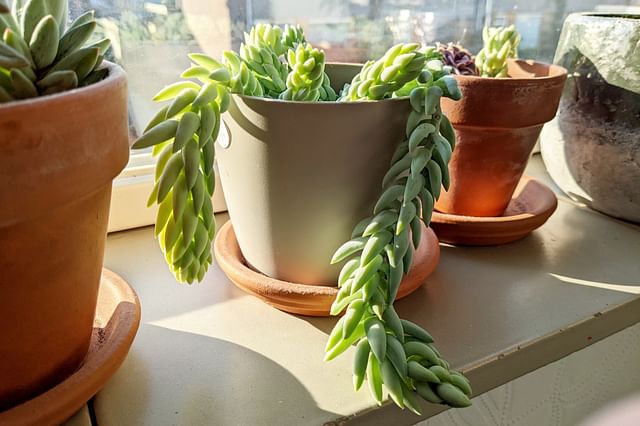
Like most succulents, the Sedum morganianum doesn't grow very quickly. Plants that don't grow very quickly don't need a lot of energy to live and survive. Your Sedum is quite happy just existing and growing like this. This is why you don't have to fertilize your Sedum Morganianum (very often).
If you want to give your sedum a boost and fertilize it, it’s important to remember that over-fertilization can be harmful to a plant. This is why it’s best to fertilize your Burro’s Tail very little. To help your Sedum stay healthy and slowly keep growing, you should fertilize it twice per year: once at the beginning of the spring and once at the beginning of the summer.
Finding the right fertilizer for your Sedum is quite easy too, as most manufacturers have created succulent and cacti mixtures. When you apply these fertilizers to the soil, make sure to always follow the instructions on the fertilizer packaging, as different brands may have different application rates.
The ideal fertilizer is one that's balanced with a 10-10-10 (NPK) ratio. This ratio indicates the percentage of nitrogen, phosphorus, and potassium in the fertilizer.
Can I use liquid fertilizer for my Sedum morganianum?
Liquid fertilizer is a type of fertilizer that you usually add to water and you apply this while watering your plant. Fertilizer is only effective when it can spread throughout the soil, so liquid fertilizer is the best choice for succulents, like the Sedum. The soil is usually too dry for solid fertilizers to be effective. The nutrients in the liquid fertilizer will be absorbed quickly and won't stay behind in the pot without doing its job.
Fertilizing your Sedum morganianum in the winter
In the winter, when your Sedum morganianum is asleep, or dormant, and it's not growing (as quickly), you shouldn't fertilize your plant. Your Sedum morganianum won't use the fertilizer and it'll stay behind in the pot.
Over time, this will leave salts behind in the pot and this is not a great place for your Sedum to grow. You can wash these salts out by watering your succulent thoroughly with clean water and letting the excess water drain away.
You can read more about which fertilizer is best in "What is the best type of fertilizer for houseplants?".
Propagating your Sedum Morganianum
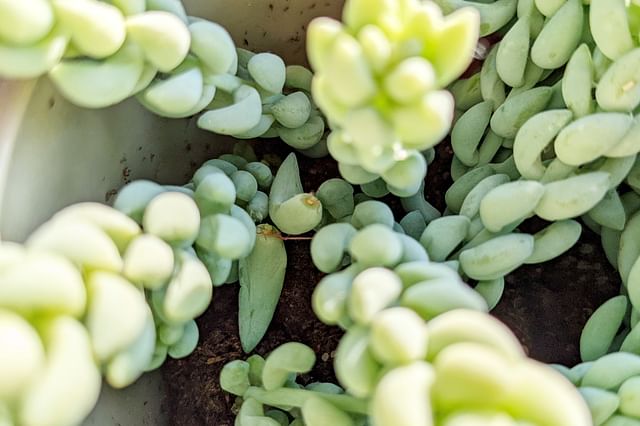
If you've taken great care of your Sedum Morganianum and it has grown long vines, you might consider propagating your succulent. By propagating your Sedum, you can make new plants and share these plants with your friends and family.
Luckily, propagating a Sedum Morganianum is very easy! All you have to do is follow a few simple steps:
- Cut off part of the vine or take off a few "leaves"
- Let the vine or leaves dry for 2 days in a sunny spot
- Plant your vine and/or leaves in the soil
- Take care of them as you would a fully-grown Sedum Morganianum
A few weeks after planting your cuttings in the soil, you should see roots growing. Your cuttings will become their own plants in a few months and after that, you'll have fully-fledged Sedum Morganianum plants! Who doesn't like free plants?
Repotting your Sedum Morganianum

The Sedum Morganianum is quite easy to grow and maintain, but when it comes to repotting this plant, there are a few things that you should keep in mind to make sure it stays healthy and continues growing.
First, it is important to choose the right pot for your Sedum morganianum. The pot should be slightly larger than the current one, but not too big as this makes the risk of overwatering much larger. The extra soil will also hold onto extra moisture.
The pot should also have good drainage holes, as this plant is prone to root rot if the soil is too wet. Make sure to use well-draining potting soil like we've looked at earlier in this plant care guide.
To begin repotting your Sedum morganianum, carefully remove it from its current pot, being mindful not to damage the roots or the leaves. Gently loosen any tightly bound roots, and remove any dead or damaged ones.
Once the roots have been prepared, place a layer of fresh potting mix at the bottom of the new pot, and then place the plant in the center, making sure that the top of the root ball is level with the top of the soil.
Fill in any gaps around the plant with more potting mix, being careful not to cover the leaves. Use a wooden stick to press down the soil lightly to remove any air pockets, and then water the plant thoroughly, until excess water drains out of the pot.
Many leaves are falling off while repotting, what do I do?
If you're repotting your Sedum, you'll notice that a lot of leaves are falling off. This is both scary and quite messy. But this is normal for this plant, its leaves fall off easily. But don't worry too much about this, as you can plant all of these leaves back into the soil and they'll start to grow roots. They'll be fine.
How can I tell if my Sedum Morganianum needs to be repotted?
Not sure when your Sedum is ready to be repotted? There are a few signs you can look out for to find out if it's ready for a new pot.
If you notice that roots are coming out of the bottom of the pot or growing out of the soil, it is a sign that the plant has outgrown its current container. This means that it needs more space to grow and develop.
Another great sign is if your Sedum morganianum is not growing as fast as it used to or the leaves are smaller in size, it could be a sign that it has used up all the nutrients in the soil and needs a fresh potting mix.
Last, but not least the soil in your plant's pot can break down and compact over time, making it harder for the roots to get the nutrients and water it needs. It can also lead to soil pests and diseases. If the soil in your Sedum morganianum pot looks tired or has become hard, it is time to repot the plant.
What should I do if the leaves of my Sedum morganianum start to wilt?
If you notice the leaves of your Sedum morganianum starting to wilt, don't worry too much. This is a natural response that the plant has to environmental changes such as bright sunlight, temperature changes, or not being watered enough. However, it is important to take action to prevent further wilting and keep your plant healthy.
Here are some steps you can take:
- Check the soil moisture: make sure the soil is lightly moist but not waterlogged. Sedum morganianum needs well-draining soil, so overwatering can lead to root rot and cause the plant to wilt. Allow the soil to dry out completely before watering again.
- Move the plant: if your plant is in direct sunlight, it may be getting too much heat which can cause wilting. Move it to a slightly darker area or provide some shade with a thin curtain.
- Trim the stems: if some of the stems are particularly wilted, it may be helpful to trim them so that your plant can focus its energy on healthier growth.
- Fertilize: sedums are not heavy feeders, but you can provide a light dose of fertilizer to encourage healthy growth.
- Be patient: It may take some time for your plant to recover, so be patient and keep an eye on its progress.
With one or more of these steps, you can help your Sedum to thrive again. You don't have to complete all of these steps, usually one of them is the real cause of the wilting leaves, so try them 1-by-1 to find what's the matter with your plant.
Now that we know how to deal with a wilting Sedum, let's look a little closer at pests and diseases that could be on or around your plant!
Pests and diseases
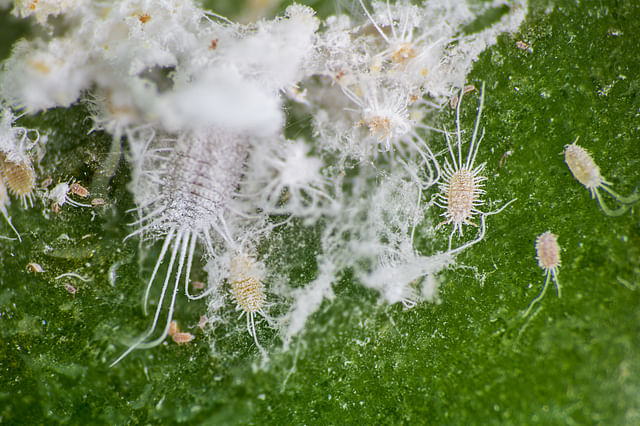
The sedum might be a tough plant, but like most other plants it could be attacked by several different pests and diseases. These pests can slow down its growth or even damage your plant, so it's important to act quickly. Let's see which pests and diseases can affect your plant.
Spider mites
One common pest that can infest Sedum morganianum is spider mites. These tiny pests feed on the sap of the plant, causing leaves to turn yellow, dry out, and eventually fall off. To get rid of spider mites, simply spray the plant with a solution of neem oil or insecticidal soap. You can also wipe the leaves with a damp cloth to remove the spider mite colonies.
Spider mites are small arachnids that are difficult to spot with the naked eye. They range in color from light green to red to brown and are usually found on the underside of leaves.
One way to detect them is to shake the plant or touch the leaves gently and observe if specks move around. By far the easiest way to tell if you've got spider mites is to see if there is any webbing on the plant. This is where the spider mites live.
Mealybugs
Another pest that can attack Sedum morganianum is mealybugs. These insects form cottony white balls on the leaves and stems of the plant, sucking nutrients from the leaves. To get rid of mealybugs, use a cotton swab dipped in rubbing alcohol to remove the bugs manually, or spray the plant with a mixture of water and dish soap. You should repeat this every few days until the bugs are gone.
Mealybugs are soft-bodied insects that are also typically found on the underside of leaves, but can also be found on the stems of the plants. They are small, white, fluffy, and have a waxy texture. At first, you can spot them when they come together in white cotton balls, which become bigger as more of them get to your plant.
You can also spot mealybugs by looking for yellowing or wilting leaves, honeydew (basically sugary syrup left by the bug), and sticky residue on the leaves and surroundings.
Root rot
When it comes to diseases, root rot is a common issue with Sedum morganianum. This happens when the plant's roots sit in soggy soil for too long, causing them to rot and eventually die. Signs of root rot include yellowing leaves and a foul smell coming from the soil.
To prevent root rot, make sure to water your Sedum morganianum only when the soil has dried out and make sure that the pot has proper drainage. If you think you might be dealing with root rot, try to remove as much of the rotting soil and roots as possible and repot your plant in fresh soil.
Now that we've tackled the common pests and diseases, let's move on to seeing if the Sedum morganianum is safe to have around pets.
Is your Sedum morganianum toxic for pets?

If you've got pets or small children and you're considering getting a new plant for your house, it's important to make sure your plants won't harm your pets or children. Luckily, a Sedum morganianum is completely safe to have around your pets and kids: it's not toxic. You can rest assured that your houseplant won't harm your pets and kids, so pick a great spot to fully enjoy your Sedum morganianum.
Conclusion
In this plant care guide, we've looked at how you can take care of your Sedum morganianum. We've looked at how to water your Sedum morganianum, the best sunlight exposure for your Sedum, the best soil for your Sedum morganianum, how to properly feed your Sedum, and whether your Sedum is toxic for your pets and kids.
Thank you for reading this post! I hope it helps you to keep your plants healthy and beautiful! If you're looking for more guides on specific plants, you can always request a plant guide to get a guide for the plant you have trouble with.
Tags: beginner-friendly, Plant care tips, drought-loving, low-light, pet-friendly, sun-loving
Posted on: Mar 12, 2022 Last updated on: Oct 19, 2023